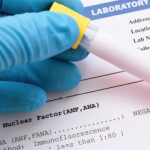 ACR CONVERGENCE 2020—Held Nov. 5–9, the ACR’s first fully virtual annual meeting is a wrap, but that doesn’t mean it’s too late to catch the highlights. Dozens of research abstracts on various aspects of lupus were presented during the fully virtual event, and David S. Pisetsky, MD, PhD, professor of medicine and immunology at Duke University School of Medicine in Durham, N.C., a staff rheumatologist at the Durham VA Medical Center and the very first physician editor of The Rheumatologist, highlighted a select few for us. “I have tried to highlight the context of the work and its importance,” he says.
ACR CONVERGENCE 2020—Held Nov. 5–9, the ACR’s first fully virtual annual meeting is a wrap, but that doesn’t mean it’s too late to catch the highlights. Dozens of research abstracts on various aspects of lupus were presented during the fully virtual event, and David S. Pisetsky, MD, PhD, professor of medicine and immunology at Duke University School of Medicine in Durham, N.C., a staff rheumatologist at the Durham VA Medical Center and the very first physician editor of The Rheumatologist, highlighted a select few for us. “I have tried to highlight the context of the work and its importance,” he says.
Dr. Pisetsky received his BA from Harvard College, Boston, in 1967 and his PhD and MD from the Albert Einstein College of Medicine, The Bronx, N.Y., in 1972 and 1973. Following house staff training at the Yale-New Haven Hospital, Connecticut, he was a clinical associate at the National Cancer Institute, Bethesda, Md. He joined the faculty of the Duke University Medical Center in 1978, where he has remained since. He served as chief of rheumatology and immunology at Duke from 1996–2007 and chief of the rheumatology section at the VA from 1978–2019.
Dr. Pisetsky has conducted basic and translational research on the pathogenesis of systemic lupus erythematosus (SLE) and the immunological properties of nuclear macromolecules. Most recently, he has investigated the immune activities of microparticles, as well as the immunochemical properties of antinuclear antibodies. In 2001, he was awarded the Howley Prize from the Arthritis Foundation for his work on the immune properties of DNA. In 2016, he received the Presidential Gold Medal from the ACR.
From 2000–05, Dr. Pisetsky served as editor of Arthritis & Rheumatism, and from 2006–11, he was the first physician editor of The Rheumatologist. He has been an associate editor of the Annals of the Rheumatic Diseases since 2012. He served as the president of the United States Bone and Joint Initiative from 2015–17.
Dr. Pisetsky’s picks for the top research in lupus presented at ACR Convergence 2020:
Abstract 0242—Autoantibody Profile and Ethnicity: Risk Factors for Accelerated Development of Lupus Nephritis
Dr. Pisetsky: In the study of SLE, anti-DNA antibodies have garnered the most attention as an anti-nuclear antibody (ANA) that can promote glomerulonephritis, putatively on the basis of immune complex deposition. The role of other ANAs in the pathogenesis of nephritis has been less certain. As this study showed, the combination of antibodies to Sm, Ro and RNP antigens (so-called RNA-binding proteins or RBPs) is associated with an increased risk of renal disease, especially in patients of African ancestry. I think this study is important in demonstrating the interplay of ethnicity and serological findings and showing the value of looking at combinations of ANAs rather than single specificities for clinical correlations. Despite tremendous advances in the development of molecular biomarkers for SLE, old fashioned serology, along with demographic findings, can provide important prognostic information and help in risk assessment, pending validation of the newer technologies.

